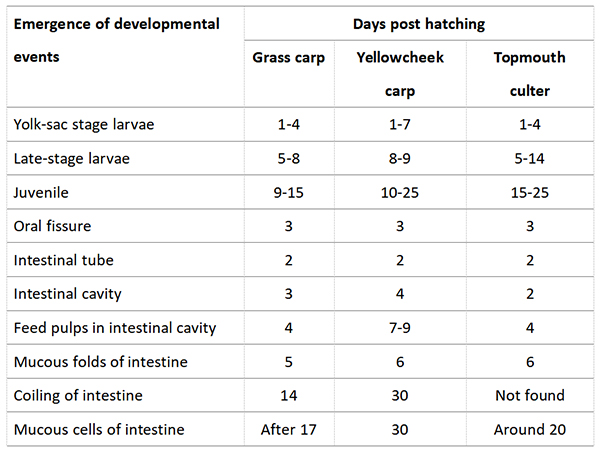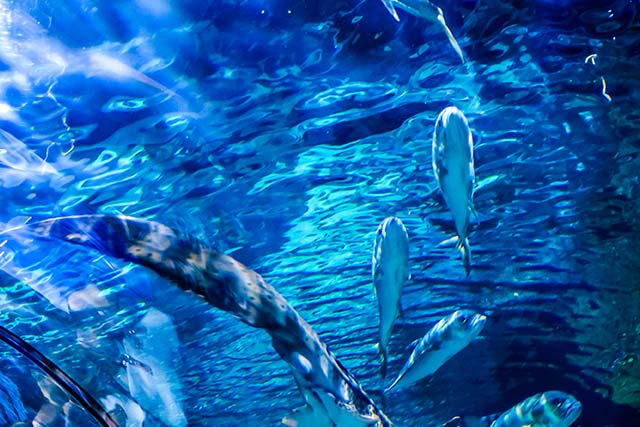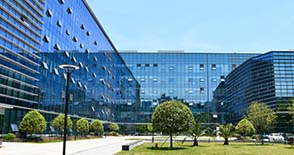13 Apr, 2022
by Yang Fan, Xiao Xiangqian
The fish intestine is an important organ for exercising digestive and absorptive functions. For fry, most of the fish fry is in a period of gradual refinement of intestinal structure and function. Therefore, it is important to pay attention to the early intestinal development of fish for the whole cultivation process.
1. Structural developmental course of the early fish intestine
The early life history of fish includes embryonic, larval, and juvenile stages. In the case of most teleosts, the occurrence of their digestive system is generally divided into three main stages.
The first stage starts from the hatching of the larvae until the end of pure endogenous nutrition. At this stage, larval development is entirely dependent on nutrients stored in their yolk sacs and oil globules. By the end of the first stage, the larvae underwent a transition from endogenous to exogenous nutrition.
The second phase begins with the establishment of exogenous nutrition until the gastric glands begin to differentiate. This phase is characterized by a still weak digestive capacity of the digestive system. Larvae at this stage mainly rely on the mechanisms of pinocytosis and intracellular digestion and absorption to obtain nutrients.
Therefore, larvae usually feed on live baits that are easy to ingest and digest, as in the third stage of rotifer development from the appearance of gastric glands and blind pyloric sac until after metamorphosis is completed, signifying that the digestive system is functionally perfect.
2. Digestive function development in the early fish intestine
During the development of larvae and juveniles, the secretion of digestive enzymes experienced three time periods. The emergence and improvement of pancreatic enzyme secretion function is the first step in the development of digestive function of larvae and juveniles. After hatching, acinar cells secreting pancreatic enzymes have appeared on the back of the digestive tract. Some studies have shown that the larvae have pancreatic enzyme activities before opening and even just after hatching, such as trypsin and amylase. Therefore, scholars believe that the pancreatic enzyme activity before initial feeding comes from the exocrine pancreatic acini, rather than the microvilli of intestinal mucinous epithelium at the intestinal brush edge induced by feed.
The emergence and perfection of enzymes constitute the second step in the development of digestive function of larvae and juveniles. Brush margin membrane enzymes are hydrolases that exist in the intestinal mucosa and are associated with the brush margin of the mucosa, including skin enzymes, disaccharidases and vinegar enzymes. With the development, the specific activities of these enzymes changed with the development, which reflected the gradual improvement of intestinal digestion, absorption and transport functions of larvae and juveniles.
The appearance of gastric glands and the formation of gastric structure become the third step in the development of digestive function of larvae and juveniles. Many studies have shown that trypsin plays an important role in the digestive function of newly hatched larvae, and the digestive tract is an alkaline environment suitable for serine proteases such as trypsin to exert their activity. Pepsin secreted by gastric glands can exert its activity in acidic environment. So far, the development of digestive tract and the digestion of feed by digestive enzymes of larvae and juveniles are basically perfect, which is close to that of juveniles and adults.
The following table shows the key nodes of digestive tract development of herbivorous and carnivorous fish.
Table 1. The ontogenic envents of grass carp, yellowcheek carp, topmouth culter and their digestive tracts

3. Nutritional requirements for early development of fish
At present, more and more attention is paid to the early nutrition of fish. Based on the relatively weak research at present, the author believes that the early nutrition needs of fish should be formulated according to the process of early intestinal structure and functional development of different fish.
a. Pay attention to the attractiveness and palatability of feed
Eating is the first step of nutrient absorption. In addition to considering the size of feed particles, we should also consider the feed attractiveness and palatability of feed, mainly in terms of smell and taste.
The type and size of olfactory stimuli should be considered. The molecule is too large to diffuse in water, so it is not easy to stimulate feed intake. Neutral, straight chain and short chain molecules have good feed inducing effect, such as alanine, glutamate, serine, etc. Of course, different concentrations of feed attractants have different effects on different fish. Secondly, cationic components also play a very good stimulating role in olfaction.
In terms of taste perception, fish mainly perceive through taste buds distributed on epithelial cells such as mouth, gill cavity, gill, tongue, pharynx and esophagus. A variety of chemicals can stimulate and induce feed intake, such as amino acids, nucleotides from yeast, fatty acids, betaine, etc.
b. Pay attention to the balance of nutrition
In the early stage of larvae, there is an obvious transformation from endogenous nutrition to exogenous nutrition. If the endogenous nutrition obtained by the larvae from the embryo is rich and reasonable, the open larvae can continue to develop with the help of part of the nutrition carried by the yolk even if they do not eat.
When endogenous nutrition is exhausted, exogenous nutrition plays a vital role in later development. The results show that the changes of the composition and content of amino acids and fatty acids in fish larvae and juveniles can provide a theoretical basis for the nutritional fortification of parents and the rational allocation of bait for juveniles and juveniles. By measuring the concentration of main nutrients in developing eggs and open larvae, the requirements of unsaturated fatty acids and amino acids of some species of embryos and larvae can be determined. Millikin (1982) confirmed by comparative biology and isotope labeling that fish need 10 essential amino acids and synthesize proteins in the body in an appropriate ratio. According to the balance theory of essential amino acids, it is effective to guide the proportion of essential amino acids in feed based on the proportion of essential amino acids in fish eggs, larvae and juveniles.
c. Pay attention to the digestion and utilization of nutrients
The digestion and absorption of feed by fish is an important life activity directly related to its growth, development and reproduction. The period of larvae and juveniles is the key stage of the development of cultured fish. The intake, digestion and absorption of bait in this stage directly affect the survival rate and growth rate of seedlings. In the early stage of fish, due to the imperfect structure and function of digestive system, the absorption and utilization rate of nutrients is not enough. In the selection of raw materials, some raw materials treated by in vitro pre digestion technology, such as GroPro Aqua and fermented soybean meal, can be selected to improve the absorption of feed nutrients.
4. Effect of GroPro Aqua on early intestinal development of fish
A large number of studies have shown that GroPro Aqua has a very good feed attraction effect. When the addition of GroPro Aqua was in the range of 1000 - 2000 mg/kg, the feed attraction effect of GroPro Aqua on Trionyx sinensis was significantly better than that of the non added group. When 12% fish meal is added to the feed, 0.5% - 1.0% GroPro Aqua can significantly promote the palatability of the feed of allogynogenetic crucian carp. When the feed fish meal is reduced to 6%, it is necessary to increase the addition level of GroPro Aqua to at least 1.0% to improve the palatability of the feed.
GroPro Aqua is rich in amino acids and nucleotides, which can enhance the activity of hepatopancreatic digestive enzymes, so as to promote its digestion, absorption and utilization of feed nutrients. In addition, adding 3% - 5% GroPro Aqua to the feed can improve the height and width of shrimp fold, promote the repair of intestinal microvilli and increase the absorption area of intestine (Table 2).
Table 2. Effects of dietary GroPro Aqua supplementation on intestinal morphology of Litopenaeus vannamei

Notes: Values in the same line with different small letter superscripts are significantly different (P<0.05).
GroPro Aqua can also repair the inflammation of the intestine caused by plant proteins. It was found that when soybean meal replaced fish meal by 50%, it would have a great impact on the digestive tract tissue of largemouth bass fry, the intestinal wall became thinner and the villi of the small intestine suffered serious mechanical damage. After adding GroPro Aqua, the intestinal condition of GroPro Aqua group was better than that of high soybean meal group, and there was no significant difference between the integrity of intestinal tissue and fish meal group, indicating that GroPro Aqua has a repair effect on the intestinal tract of largemouth bass.
In summary, GroPro Aqua as high quality functional protein, can improve gut health and improve feed palatability at early stages in aquatics.
| Published by Yang Fan Engineer of Aqua Nutrition Division |
About Angel Animal Nutrition:
Fubon is a brand of Angel Animal Nutrition. Fubon is committed to developing natural, efficient microbial feed derived from yeast with Angel's leading technology in yeast industry, providing the best service solutions for the nutrition and health in animals. Angel Animal Nutrition creates value for global feed and animal agriculture customers through continuously upgraded products and professional services.
About Angel:
Angel Yeast Company is a high-tech listed company specializing in yeast and biotech. Product business covers Yeast and Baking, Yeast Extract-Savoury, Nutrition & Health and Biotechnology fields. It is one of the world's leading companies in the yeast industry. Angel has 12 holding subsidiaries and provides products and services for more than 150 countries and regions.
Press Contact:
ANGEL YEAST CO.,LTD
Address: 168 Chengdong Avenue, Yichang, Hubei 443003, P. R.China
Tel:+86-717-6369520, 6369558
Fax:+86-717-6370680
email: aie@angelyeast.com








